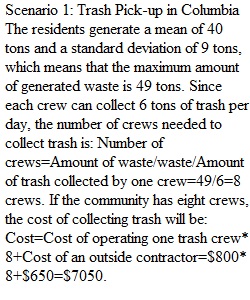


Q Scenario 1: Trash Pick-up in Columbia Residents of Columbia, MD place their trash at the curb each Wednesday morning to be picked up by municipal crews. Experience shows that the total amount of trash put out has a normal distribution with a mean of 40 tons and a standard deviation of 9 tons. Crews of full-time city employees collect the trash. Each crew can collect 6 tons of trash per day. The city has plenty of trucks of the kind used for trash collection. The marginal cost of operating one trash crew for one day including both personnel-related and truck-related costs is $800. Whatever trash remains at the end of the work day be collected that evening by an outside contractor who charges $650 per ton. How many crews should the city assign to trash collection to minimize expected total cost? In other words what number of crews (1, 2, 3, etc.) produces the lowest expected cost?
View Related Questions